Jefferson Lab Front Page Pictures and Captions 2009
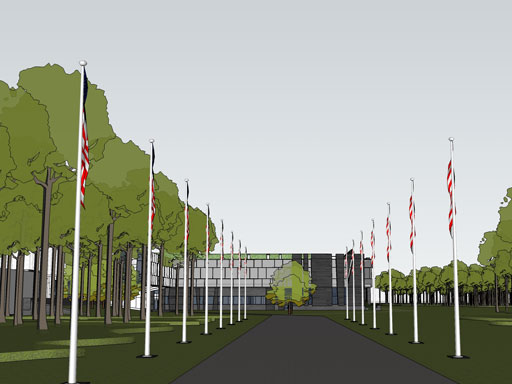 Changing Landscape - A $73-million project to construct a new engineering and technology facility and modernize another facility at Jefferson Lab is now in the final design phase. The Technology and Engineering Development Facility project will not only provide state-of-the-art facilities for research, it will also change the face of the laboratory complex. |
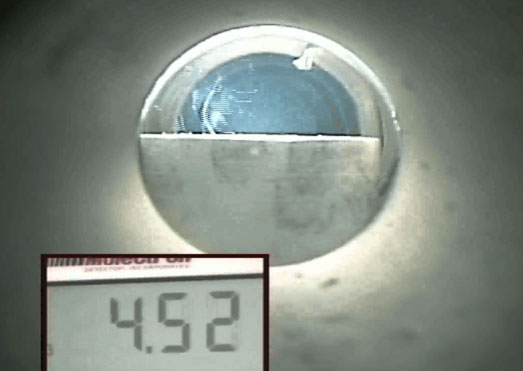 Nanotubes Exposed - This video shows fibrils of boron-nitride nanotubes as they are formed when a free-electron laser beam strikes a target of pressed boron powder. The rotating target distributes the laser heat evenly, and the number indicates laser power level in arbitrary units. Click to view. |
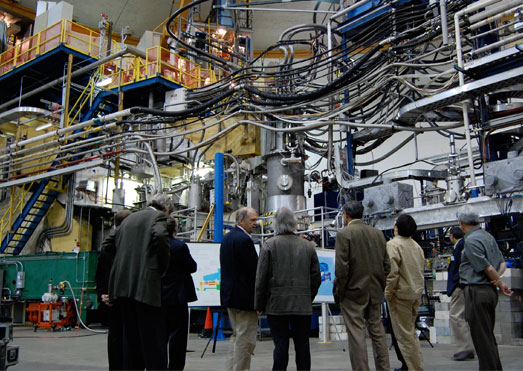 Electrons and Ions - The Electron-Ion Collider Advisory Committee met at Jefferson Lab Nov. 2-3 to discuss the future machine. Here, Hall A Leader Kees de Jager (center) describes Hall A's apparatus and experimental program to some committee members on a short tour of JLab's facilities Tuesday. An electron-ion collider is the long-range priority for the field of nuclear physics. |
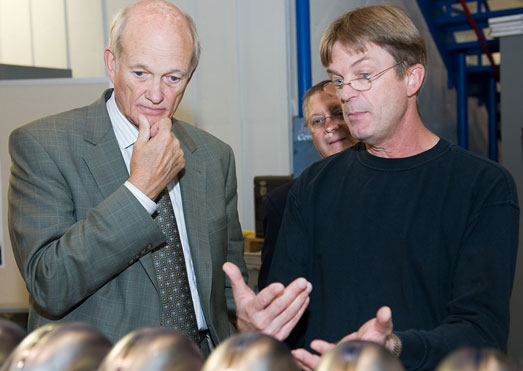 William F. Brinkman, Director of the Department of Energy's Office of Science, views an R&D superconducting radio frequency accelerator cavity. Joe Preble, leader of the cryomodule development and production group, explains SRF R&D at Jefferson Lab while DOE Thomas Jefferson Site Office Manager Jim Turi looks on. Brinkman visited the lab Oct. 28. |
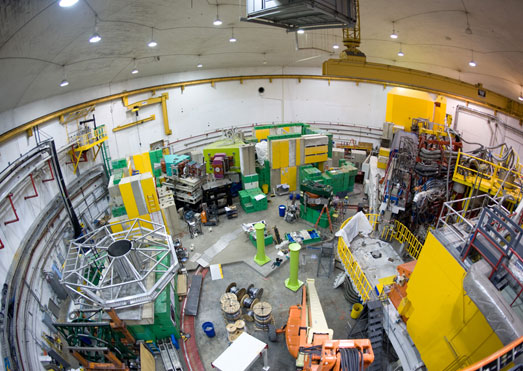 Hypernuclei in Hall C - Nuclear scientists have gone to great lengths to pry open the nucleus and peer deep inside. They've manipulated its spin, bombarded it with any number of exotic particles and subjected it to heat and pressure not seen since millionths of a second after the Big Bang. Now Jefferson Lab's Experimental Hall C, shown here during equipment installation, plays host to an experiment taking a different approach. (Photo: Greg Adams) |
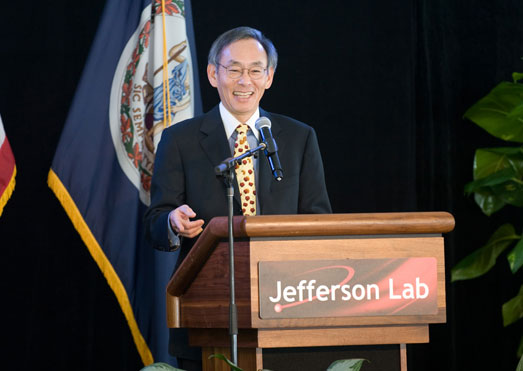 U.S. Energy Secretary Steven Chu delivered the keynote address at Jefferson Lab's 25th anniversary celebration on Sept. 29. During his talk, he discussed the importance of nuclear physics research to the U.S. He also called upon the U.S. to take the lead in combating global warming, explaining that by taking the lead in green technologies the U.S. could ensure its future prosperity. |
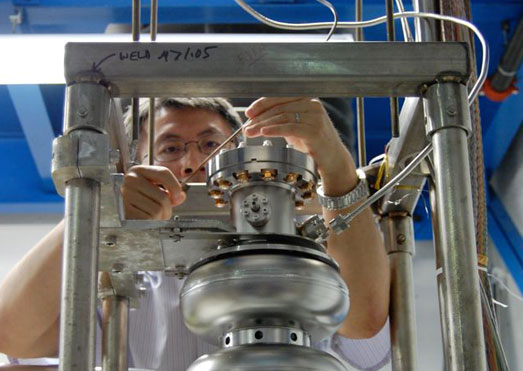 Practice Makes Perfect - Rongli Geng, a staff scientist in Jefferson Lab's Institute of Superconducting Radiofrequency Science and Technology, connects a cable to an International Linear Collider prototype accelerator cavity as he prepares it for testing. Geng is working to improve the performance of superconducting radiofrequency cavities for future accelerators. |
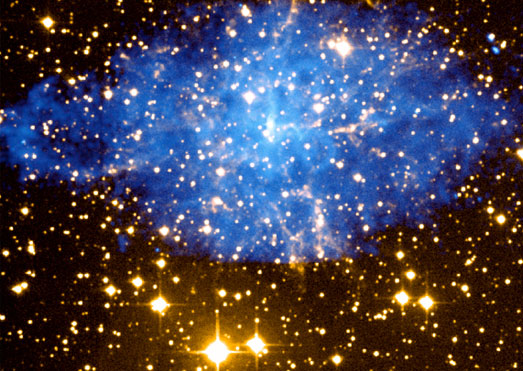 Star Experiment - When astronomers first identified this nebula, dubbed 3C58, they thought it was the remnant of a supernova recorded in 1181. But now, they aren't so sure. The nebula is expanding much more slowly and the star at the nebula's core is cooler than expected. The chance to solve this mystery is just one of the reasons that a diverse group of physicists are gathering in Trento, Italy for a workshop on Jefferson Lab's PREx experiment. |
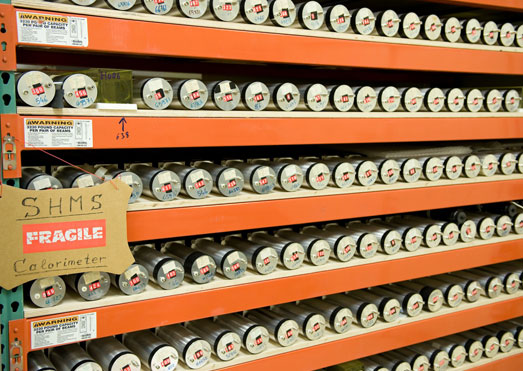 Light Catchers - These lead glass blocks and photomultiplier tubes will be used in the new Super High Momentum Spectrometer, to be built for Hall C to support high-luminosity experiments in the 12 GeV Upgrade physics program. The glass blocks and photomultiplier tubes were previously used by the HERMES experiment at DESY in Germany and will be assembled into a detector designed by researchers from the Yerevan Physics Institute. |
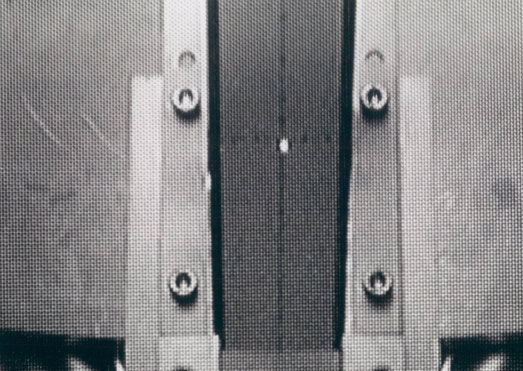 First Beam On Target -Fifteen years ago, at 4:45 p.m. on July 24, 1994, electrons pinged a target in an experimental hall for the first time at Jefferson Lab. A Polaroid shows the electron beam shining onto an early target, made of beryllium oxide. (Photo: Roger Carlini) |
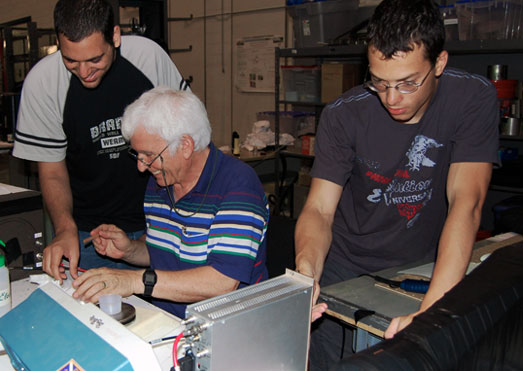 Detector Inspectors - Or Chen (left) and Moshe Zilka (middle), both of Tel Aviv University, prepare to assemble a neutron detector, while Dominik Wermus (right), a student from Virginia Military Institute, tests a component for the detector. The detector will be used in an upcoming experiment in Hall A. Wermus is spending the summer at JLab in the DOE's Science Undergraduate Laboratory Internships program. |
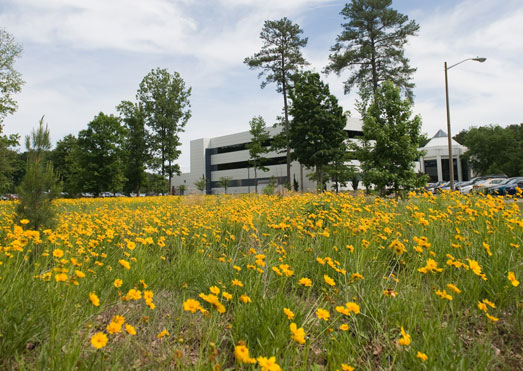 Green is Golden - Jefferson Lab has been recognized again for environmental stewardship, earning a 2008 Hampton Roads Sanitation District Pretreatment Excellence Gold Award for perfect industrial wastewater permit compliance in 2008. Another green initiative is the planting of about 7.5 acres of wildflowers, such as this scene near CEBAF Center. Replacing grass with wildflowers reduces fuel use and emissions from mowing equipment. |
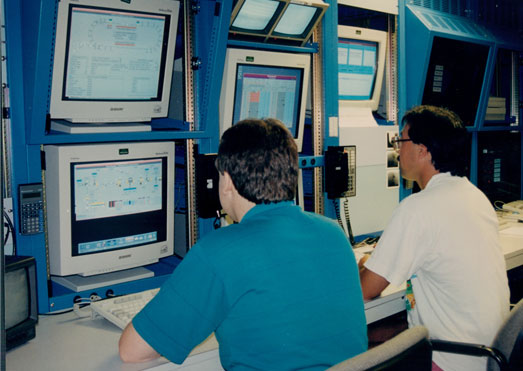 Of Historical Importance - Fifteen years ago on June 6, Jefferson Lab's accelerator, the world's first large installation of superconducting radiofrequency technology, reached operational temperatures. A small contingent of accelerator operators watched as the temperature of accelerating components inside the CEBAF accelerator plunged below a chilly 2.6 Kelvin (-454.99 degrees Fahrenheit) for the first time. Photo of Machine Control Center (1995). |
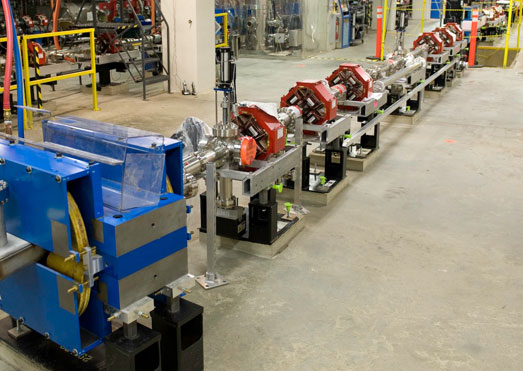 Double Duty - The Free-Electron Laser is poised to open a new realm of discovery. The world's most powerful tunable laser in the infrared is about to also become the world's most powerful tunable laser in the ultraviolet. The final piece has just been installed in the FEL's new ultraviolet beamline. Soon, the FEL will be capable of delivering both infrared and ultraviolet laser light (not simultaneously) to its experimental areas. Photo: Greg Adams |
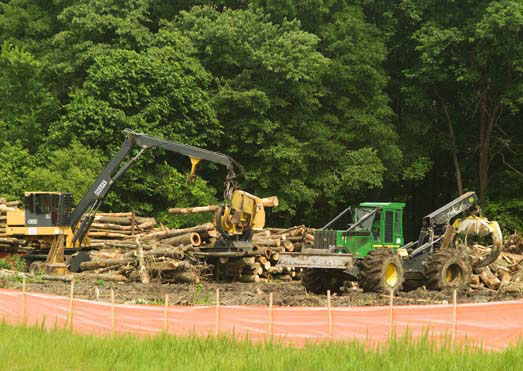 Making Progress - Construction crews have started to remove trees as work on the $310 million 2 GeV Upgrade gains momentum. Hall D, the lab's fourth experimental hall, will be constructed in the cleared area. The upgrade is scheduled for completion in 2015. |
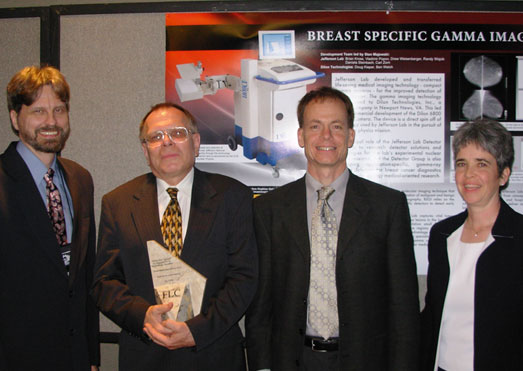 Award Winners - Randy Wojick, Stan Majewski, Drew Weisenberger and Daniela Stenbach of Jefferson Lab's Radiation Detector & Imaging Group recently won an excellence award from the Federal Laboratory Consortium for Technology Transfer for the development and commercial production of a compact gamma camera for improved detection of breast cancer.. |
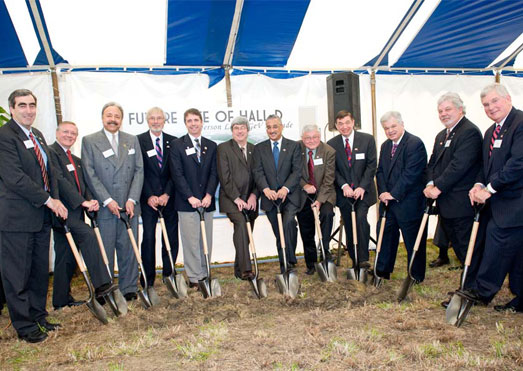 Groundbreaking - The next era of exploration into the heart of matter reached a significant milestone today, as Jefferson Lab officially broke ground for its 12 GeV Upgrade. The $310 million project will be completed in 2015. The upgrade will provide a cutting-edge research facility for the international nuclear physics community for decades to come and thus allow the lab to continue to contribute to the economic vitality of the local community. |
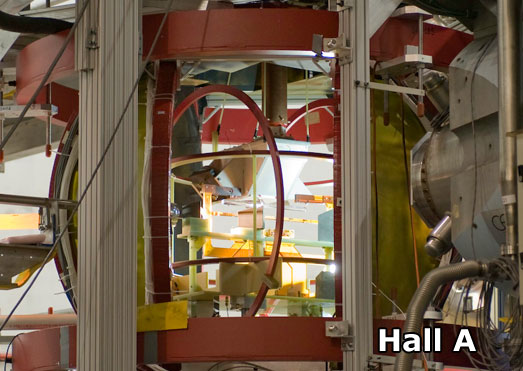 All Spun Up - A milestone achieved during the latest experimental run put a new spin on Jefferson Lab physics. For the first time, all three halls ran polarized experimental targets (target particles spin in unison) while also receiving polarized beam. The polarized targets in Halls A, B and C are shown |
 Green Machine - A team will use a small, two-headed Positron Emission Tomography (PET) system, shown here, to perform Carbon-11 plant research at the Duke University Phytotron. The system was designed and built by members of Jefferson Lab's Radiation Detection and Imaging group. Group leader Drew Weisenberger says the goals are to research and develop techniques and methodologies for measuring plant responses to wounding (such as herbivory) |
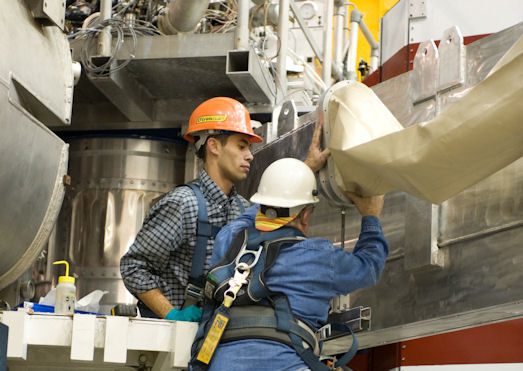 Spotlight on Spin - A long-anticipated measurement is underway in Jefferson Lab's Hall C. Researchers are investigating quark-gluon correlations in the proton using its spin. Matthew Lumanog (left) and Charles Lassiter install a helium bag to contain unused electrons and other particles generated during the experiment along the beam line. |
 Source Tester - Marcy Stutzman, a staff scientist in the Center for Injectors and Sources, makes adjustments to the Compact Retarding Field Mott Polarimeter. The polarimeter allows the group to characterize photocathodes - the source of electrons for Jefferson Lab's CEBAF accelerator - before installation. |
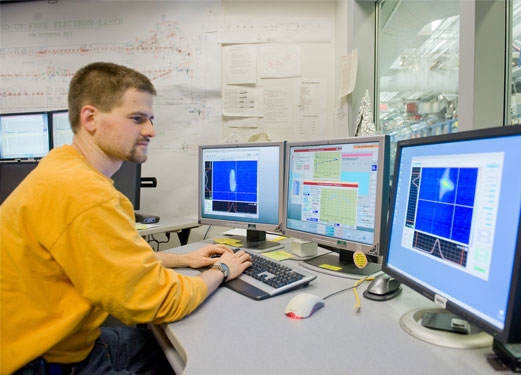 Beam Me Up, Chris! - Chris Tennant, an accelerator scientist in the Free-Electron Laser Division, tests electron beam transport in the energy-recovering linear accelerator while in the FEL Control Room. The ERL powers the free-electron laser. |
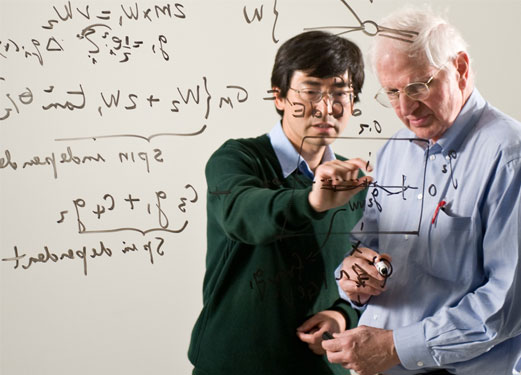 Chalkboard Chit-Chat - Hall A Staff Scientist J.P. Chen and Theory Center Principal Staff Scientist Franz Gross discuss the projected precision of upcoming measurements of the spin structure functions of protons and neutrons. The goal of these measurements is a new understanding of the interactions between quarks and gluons in protons and neutrons |
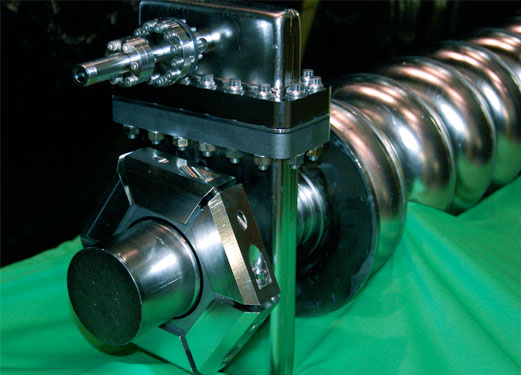 Second Chance - This accelerator cavity was worn out. It had been washed, baked and tested so much that its performance suffered, eventually declining below minimum specs. Researchers undertook a last-ditch effort to breathe new life into the beleaguered cavity and were rewarded with an astounding result. Photo: Dean Golembeski |
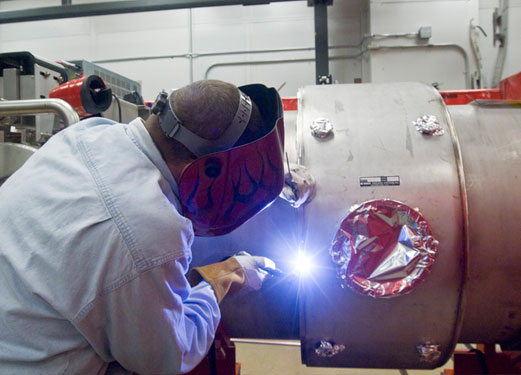 Closing up - Ken Worland, an SRF senior technologist in Jefferson Lab's Institute for Superconducting Radiofrequency Science and Technology, makes a closing weld on a bridging ring of a newly refurbished cryomodule for the CEBAF accelerator. This is one of the last steps in refurbishing cryomodules before re-installation into CEBAF. |
 Getting Things Straight - David Kashy (left), Hall B lead engineer, and Jim Dahlberg, survey group coordinator, discuss the alignment of the magnets and detectors for a current experiment in Hall B. One goal of the two-part experiment is to help physicists understand how the complex structure of protons and neutrons leads to their properties, such as mass and spin. |

